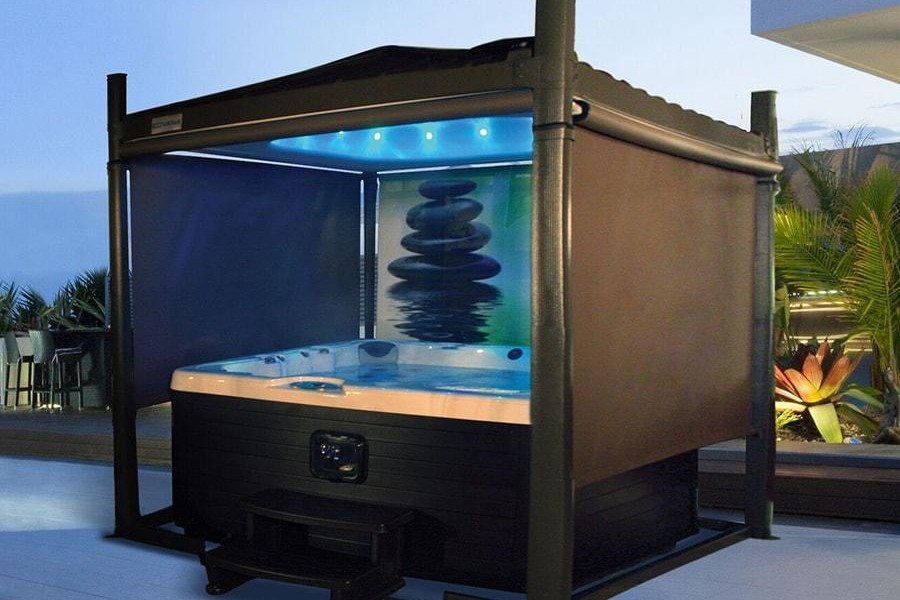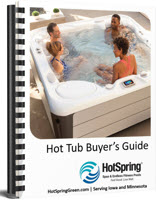
Does the weather stop you from enjoying your home hot tub? Perhaps the snow or rain disrupt your plans to walk out into the yard and relax in the warm water. One of the greatest joys of owning a hot tub is warming up in the water throughout the winter months—when you can make it happen. Maybe it’s the hot sun that overwhelms you during your daily soak. Regardless of the season, don’t let unexpected weather forecasts or season-long extremes get in the way of your well-deserved hydrotherapy.
A hot tub enclosure may be just the thing to resist the elements and allow you to enjoy the warmth and massaging jets of your spa all year round, whatever the weather may bring.
Your first step is to consult with an expert who can point you in the direction of your building, plumbing, and electrical needs. A hot tub enclosure can provide long-term shelter and enjoyment but only if done carefully and correctly. Turn to expert contractors for up-to-code construction and a spa enclosure that is specifically suited to your home.
WHAT DO TEMPORARY HOT TUB ENCLOSURES HAVE TO OFFER?


When you’re searching for a hot tub enclosure, one of the first things you’re likely to come across are temporary options. These are typically lightweight structures that snap or bolt together and are covered with a waterproof cloth. Temporary enclosures provide shade, but as they’re usually open-sided, they do not provide much protection from the wind or other elements. In cases of extreme weather, you may need to pack up these temporary hot tub enclosures to avoid damage.
A spa side umbrella may be a better choice if you’re looking for shade and minimal shelter. It is a less-expensive option than a temporary hot tub enclosure, and it is anchored by a steel plate that slides beneath the spa. It is more solid than temporary structures held down by stakes, and you can easily put it into storage in cases of severe weather.
A spa side umbrella can shield you from the sun and light rain. If you’re looking for an all-season hot tub enclosure, you may need something more permanent that fully surrounds the hot tub.
A Covana automated gazebo cover is another great option. They are completely automated gazebos which offer you maximum comfort, safety and intimacy. You can order them with different backdrops or shades. In the turn of a key your hot tub or swim spa can turn itself from a locked down cover to a beautiful gazebo for privacy.
BUILDING HOT TUB ENCLOSURES TO RESIST THE WEATHER

For year-round protection of your hot tub space, your options include pre-made structures or enclosures and additions built precisely for your needs. Pre-made hot tub enclosures range from bolt-together structures of metal or plastic with windows and screens to kits that include everything to construct a free-standing building in your yard. Home additions are more permanent solutions, but they give you the flexibility to customize your hot tub enclosure.
Whatever you decide is the best hot tub enclosure for you, remember that all work should be done by a qualified contractor, electrician (Iowa’s preferred), or plumber with the skills to do the job. You want to relax safely and comfortably for the long term while enjoying everything your hot tub enclosure has to offer, so be sure that it’s built correctly and to code.
Here are some very important things to keep in mind before you build:
- The foundation of any hot tub enclosure is critical. A permanent enclosure will stand outside all year long, and how well it is grounded will determine how well it resists the weather.
- A hot tub enclosure must provide enough space to be safely wired. When wiring a 240 volt hot tub, you’ll need to be aware of special code requirements. This includes a GFCI switch that must be at least five feet away but clearly visible from the hot tub.
- Ventilation for the steam that comes from the hot tub. The warm water from a spa creates a lot of humidity, which can collect on the inside of your room or other enclosure. To avoid related complications, it’s important to ensure that your hot tub enclosure has adequate ventilation. We’ll discuss steps to installing proper ventilation below.
Prefabricated hot tub enclosures must be large enough to accommodate safe electrical requirements. And they may have limited flexibility for wiring, ventilation, and other fixtures. But this might be the right choice if you’re looking for a less-than-permanent option.
Home additions and from-scratch structures may offer more customizability when checking off the necessary foundational, electrical, and ventilation requirements. And you may have many creative and flexible options to adapt a hot tub enclosure. An uncovered patio can be easily roofed over. The posts that hold up this roof can be framed in to create a wall for more complete shelter. Often, a power outlet is already available for you to plug in a hot tub. If you’re planning to wire your spa directly to the home’s power, then this lead is already in place and an electrician can change it to run at 240 volts and place the GFCI in a safe location. Powering a ventilation fan is also easier when the connections are already there.
ENSURING PROPER VENTILATION FOR YOUR HOT TUB ENCLOSURE

One of the most important things to be aware of is ventilation—whether you’re dealing with a hot tub enclosure, a home addition, or putting your hot tub in a basement. The high humidity your hot tub creates can be damaging to these structures.
In a warm environment, you can open the windows of your hot tub enclosure after you are done using your hot tub and let the steam out. In the middle of a cold winter, this is probably not a good solution because the water can simply freeze to the interior surfaces of the enclosure. Conversely, in a humid environment like Florida or the southeast, opening up the windows will not help because the environment outside may have more moisture than the interior.
A powered ventilation system is the key to a truly all-season hot tub enclosure. These are inexpensive and available at any home improvement store. They mount directly over the hot tub or in an exterior wall of the hot tub enclosure to allow the venting of excess moisture with the flip of a switch. An expert building contractor will be able to determine the best ventilation solution for your home and your best hot tub experience.
When you’ve taken the necessary precautions, a hot tub enclosure gives you the opportunity to relax and soak regardless of the weather conditions outside. In winter, you can marvel at the way snow smooths over the imperfections you normally see. In the pouring rain, you can relax while listening to your hot tub playlists or to the rain on the roof. The secret is simply to build a hot tub enclosure the right way and to match it with a hot tub that is well-built and equally reliable.
The post Hot Tub Enclosures For Every Season appeared first on Hot Spring Green.





